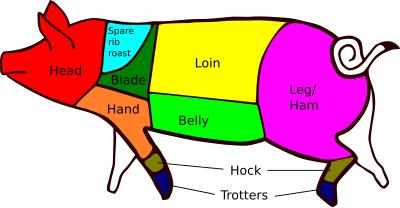Cut of pork


The cuts of pork are the different parts of the pig which are consumed as food by humans. The terminology and extent of each cut varies from country to country. There are between four and six primal cuts, which are the large parts in which the pig is first cut: the shoulder (blade and picnic), loin, belly (spare ribs and side) and leg.[1][2] These are often sold wholesale, as are other parts of the pig with less meat, such as the head, feet and tail. Retail cuts are the specific cuts which are used to obtain different kinds of meat, such as tenderloin and ham. There are at least 25 Iberian pork cuts, including jamón.[3]
Cuts
Head
The head of the pig can be used to make
Blade shoulder

Above the front limbs and behind the head is the shoulder blade.
Shoulder arm picnic
The arm shoulder[2] can be cured on the bone to make a ham-like product or be used in sausages. The hands (or paletas in Ibérico pigs) refer to the front legs, as opposed to the hind legs, which are hams or jamones.[3] Between the paleta and the belly is a 150-200 g cut known as secreto which is very popular in Spain.[3]
Loin

The
Fatback
The
Spare ribs
Spare ribs are taken from the pig's ribs and the meat surrounding the bones. St. Louis–style spareribs have the sternum, cartilage and skirt meat removed. The term abanico is used to refer to the ribs of Iberian pigs. It is very fatty and commonly barbecued.[3]
Belly or side

The belly, although a fattier meat, can be used for steaks or diced as stir-fry meat. Pork belly may be rolled for roasting or cut for
Legs or hams

Although any cut of pork can be cured, technically speaking only the back leg is entitled to be called a ham. Legs and shoulders, when used fresh, are usually cut bone-in for roasting, or leg steaks can be cut from the bone. Three common cuts of the leg include the rump (upper portion), centre, and shank (lower portion). The ham of Iberian pigs is known as jamón.
Ham hock
The joint between the feet and the leg, known as ham hock or pork knuckles, is cooked in many European countries, including Austria (stelze), Czech Republic (koleno), Germany (eisbein and schweinshaxe), Hungary (csülök), Poland (golonka), Spain (codillo), Sweden (Fläsklägg) and Switzerland (wädli).
Trotters
Both the front and hind
Chitterlings
The intestines (
Tail
The tail has very little meat as it is mostly composed of connective tissue. It can be roasted or fried, which makes the skin crisp and the bone soft. It has a strong flavour.[8] Leonese botillo is made of chopped tail, ribs and bones, which are seasoned, stuffed in the cecum and smoked.
See also
References
- ^ )
- ^ a b c Cattleman's Beef Board & National Cattlemen's Beef Association. Uniform Retail Meat Identity Standards Archived 2009-03-27 at the Wayback Machine. Retrieved 11 July 2007.
- ^ ISBN 9788483568774.
- ^ "Fried Pig Ears with Hot Sauce". Cooking Channel. Archived from the original on 2017-04-05. Retrieved 2017-04-30.
- ^ Simpas, Jica. "Pepper's English-Filipino Cheat Sheet: Common Pork Cuts". Pepper.ph. Retrieved 7 February 2023.
- ^ "What Food Each Part of a Pig Makes (and their cuts)". Village Bakery. Village Bakery. 2017-10-02. Archived from the original on 3 December 2017. Retrieved 27 October 2017.
- PMID 28239133.
- ^ a b Hugh Fearnley Wittingstall. "The River cottage cookbook". Harper Collins.
